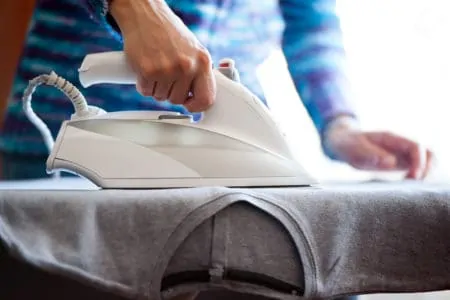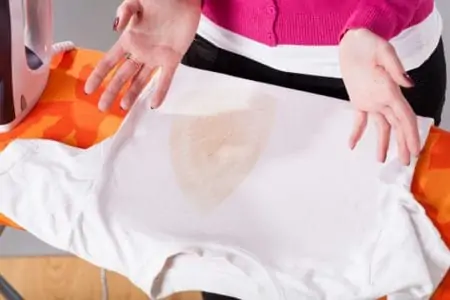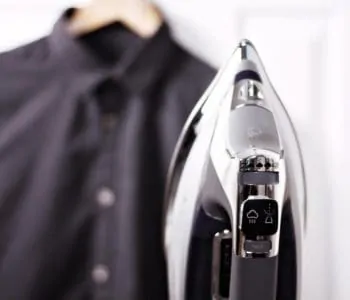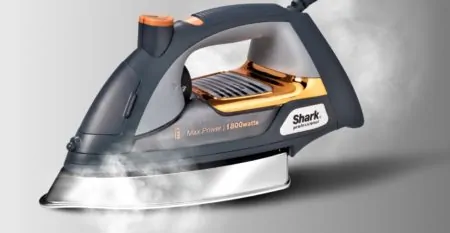When it comes to ironing, there are quite a lot of rules. Each garment and material requires a different heat and steam setting.
We’ll teach you how to iron polyester curtains, dresses, shirts and pants. Keep in mind our top tips and unbreakable rules when it comes to ironing polyester. With this ultimate guide, you’ll never ruin another polyester garment again.
Key Takeaways
- Always check the care label before ironing polyester to find the correct heat setting.
- Turn the polyester garment inside out and use a damp cloth between the fabric and iron soleplate.
- Iron the garment in vertical motions using a low to medium heat setting until wrinkles are removed.
- Hang the garment up immediately after ironing to prevent further wrinkles from forming.
What Is Polyester?
Polyester is a man-made, synthetic material derived from petroleum (1). Most polyester fibers are made from ethylene, a hydrocarbon. The ethylene glycol is mixed with an acid to create polyester (2). This all sounds complicated, but basically, polyester is a type of plastic.
Polyester is one of the most popular and commonly used materials in the world. It can be used for all types of things such as clothing, home furniture, industrial use, technology, insulation and much more. It has many advantages, including (3):
- It doesn’t absorb moisture (which makes it great for workout gear).
- It is great for water, soil and fire-resistant finishes.
- Some polyester is stain resistant.
- Fabrics don’t shrink or go out of shape.
- It’s easy to dye.
- It acts as a hypoallergenic insulator.
- It’s affordable.
- Some polyester garments are naturally wrinkle resistant.
Although polyester has many advantages, there are two big drawbacks. One is that polyester is heat-sensitive, so it can melt when exposed to high temperatures during the washing, drying or ironing routine (4).
The second drawback is that polyester is contributing to greenhouse gases. In 2014, polyester was responsible for 40 percent of the fashion industry’s emissions (5).
Can You Iron 100% Polyester?
Yes, you can iron 100% polyester. However, it is vital that you look at the garment’s care label first to see if this is recommended. If not, we don’t advise ironing the item. Instead, you could try steaming it with a handheld steamer.
How to Iron Polyester
We’ll provide a step by step tutorial for ironing different polyester items. For each section, we recommend a steam iron. Steam is gentler on polyester and can eliminate wrinkles without the need to apply heat directly to the fabric.
How to Iron Polyester Curtains
- Lay the curtains flat on an ironing board or blanket.
- Check the garment care label to see the recommended iron settings. It will likely be “warm.”
- Plug your iron in, turn it on and set it to the warm setting. Allow it to heat up.
- Place a thin cloth or towel over the curtains to protect the polyester from direct heat. Iron over this cloth rather directly onto the curtains.
- Iron the curtains until the wrinkles are gone. Start from the top of the curtains and work your way down, going width ways.
- Once you’ve finished ironing a section, let it cool and then move the curtains along the board to iron the next section.
- If the wrinkles are stubborn, use steam or spray the fabric with water before ironing over it again.
- Hang the curtains up immediately to let gravity pull out extra wrinkles.
Use The Steam
How to Iron a Polyester Dress
- Read the garment care label to check the best temperature and steam settings for the dress.
- Take away removable features from the dress such as a belt or tie wrap.
- Turn the dress inside out.
- Lay the dress flat onto the ironing board.
- Put a damp thin cloth or towel over the dress. This helps get out stubborn wrinkles without damaging the polyester fabric.
- Plug in your iron, turn it on and set it the appropriate temperature.
- Start at the collar and sleeves of the dress, ironing upwards.
- Make your way down the dress, keeping the iron pointing upwards. Continue in vertical movements, so that you’re ironing in one direction.
- Turn the dress over and iron the back.
- Hang the dress up as soon as you’re finished.
If the dress is larger, you can pull the skirt around the board, so the board is between the front and back of the dress. This is especially useful for floaty dresses or dresses that don’t fit on the board.
Caution
How to Iron Polyester Dress Pants
- Check the garment care label. Many dress pants may be a polyester blend, so look at the advice on the care label for temperature and steam settings.
- Lay the dress pants on the ironing board, with the board inside one leg at a time.
- Plug the iron in, turn it to the correct setting and allow it to heat up.
- First, iron the pocket linings.
- Next, place a damp cloth or towel over the trousers. You’ll be ironing over this instead of applying direct heat to the fabric.
- Iron the waistband and top of the trousers. Press and lift as you go, instead of smoothing the iron over the fabric.
- Move to the leg of the trousers. Fold it at the crease for a professional finish. Press and lift the iron all the way down the leg.
- Press and lift the iron at the cuff of the dress pants.
- Repeat on the other side of the dress pants, starting with the waistband and top. Then move to the leg.
- If the seat and front of the trousers have new wrinkles, eliminate them while still ironing over the damp cloth.
- Once complete, hang the trousers immediately.
How to Iron a Polyester Shirt
- Check the garment care label for temperature and steam setting advice.
- Dampen a cloth or thin towel, too — for extra help getting out wrinkles without ruining the fabric.
- Undo all the buttons and lay the shirt on the ironing board face down, with the collar on the board.
- Plug in the iron, turn it on and let it heat up.
- Put the cloth over the collar so that the soleplate of the iron never comes in direct contact with the fabric.
- Open the collar flat and iron the back of it, from the edges working your way into the middle.
- Next, open the cuffs and iron them working from the outside in. Repeat on the other cuff. Avoid ironing over the buttons.
- Next, lie out the sleeves and smooth with your hand before ironing the shirt. Start at the cuff and work up to the shoulders, keeping your cloth over the garment to avoid direct heat to the fabric.
- Next, iron the back of the shirt. If the shirt has pleats, iron carefully around them. Move your shirt around the board to make sure you iron every inch of the garment.
- Next, iron the shoulders of the shirt. Repeat on each side.
- Now, it’s time to iron the front — also known as the placket — of the shirt. Go in lengthways movements up the front of the shirt. Repeat on the other side. Be careful around the buttons.
- Iron the front of the collar. Use the same technique as you did for the back, working from the outside in.
- When you’re done ironing, hang the shirt immediately instead of folding. While the garment is still warm, any wrinkles can set while it’s cooling. So it’s important to hang it up so gravity pulls out remaining wrinkles.
Bonus Tip
FAQs
Strike While the Iron Is Warm
With polyester, you want to strike while the iron is warm — not hot. It’s important to keep the temperature and steam settings controlled when ironing polyester garments. That way, you don’t melt, scorch or stain them.
Whether you’re ironing a polyester dress, curtains, pants or a shirt, our tips have you covered. Now you can go into any situation — an interview, party or date — with a wrinkle-free and impressive outfit!













